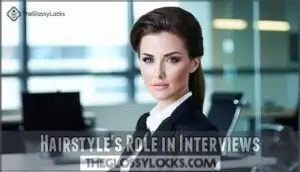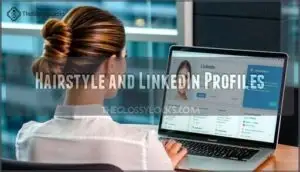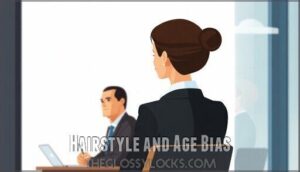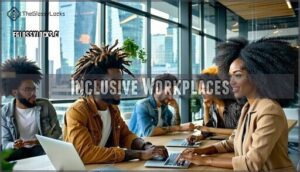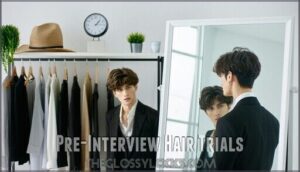This site is supported by our readers. We may earn a commission, at no cost to you, if you purchase through links.
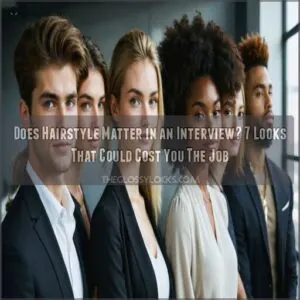
It forms part of your first impression and signals your professionalism.
You’ll want a neat, clean style that fits the company culture—conservative industries prefer traditional looks, while creative fields allow more expression.
Your hair communicates attention to detail and respect for the opportunity.
Think of it as another tool in your interview toolkit, alongside your resume and answers.
Clean, well-maintained hair in a comfortable style helps you focus on what really matters: showcasing your skills.
The right hairstyle won’t get you hired, but the wrong one might cost you the job, emphasizing the importance of making a good professionalism.
Table Of Contents
- Key Takeaways
- Hairstyle’s Role in Interviews
- Unprofessional Hairstyles
- Professional Hairstyles
- Hairstyle and Personality
- Hairstyle and LinkedIn Profiles
- Hairstyle and Age Bias
- Inclusive Workplaces
- Pre-Interview Hair Trials
- Hair Maintenance for Interviews
- Frequently Asked Questions (FAQs)
- Does hairstyle matter in an interview?
- Should you wear curly hair at an interview?
- Should you choose a hair up hairstyle during a job interview?
- Should you wear your hair up or down for an interview?
- How do you style your hair during an interview?
- Does the color of hair matter in an interview?
- Do interviewers look at your hair?
- Is it unprofessional to have your hair down in an interview?
- What hairstyle is best for an interview?
- Is a haircut necessary for a job interview?
- Conclusion
Key Takeaways
- Your hairstyle plays a big role in first impressions, signaling professionalism and attention to detail.
- Stick to neat, polished styles that align with the company culture to keep the focus on your qualifications.
- Avoid overly elaborate or distracting hairstyles that might shift attention away from your skills.
- A comfortable, well-maintained hairstyle boosts your confidence and helps you perform better in interviews.
Hairstyle’s Role in Interviews
You’ll make a lasting impression within seconds of walking into your interview, and your hairstyle speaks volumes before you say a word.
Your hairstyle tells your story before you even speak—make it a chapter of confidence and professionalism.
Your chosen look can either enhance your professional image or distract the interviewer from your qualifications, potentially affecting their hiring decision, which is why it’s crucial to make a good impression with your overall appearance, including your hairstyle.
First Impressions
Your hairstyle forms a critical part of the visual cues that shape an interviewer’s initial perception.
Within seconds of walking through the door, your chosen style sends silent signals about your professionalism and attention to detail.
Research shows that 70% of employers make judgment calls based on appearance before you’ve even spoken.
Here’s a short, engaging blockquote in the same professional tone as the article:
First impressions happen in seconds—your hair speaks before your resume does.
A well-groomed, interview-appropriate hairstyle can provide a confidence boost that radiates throughout your conversation, while an inappropriate one might create lasting impact for the wrong reasons.
Consider your hairstyle an extension of your resume – it should communicate competence and readiness for the position.
Professionalism Reflection
After first impressions, your interview hairstyle reinforces your professional appearance and readiness for the role. A polished style aligned with industry standards can enhance confidence while minimizing cultural bias.
A high-quality wig can also substantially boost self-confidence.
- Choose styles that complement your facial features.
- Avoid overly elaborate or distracting looks.
- Match your hairstyle to the company’s culture.
- Keep it neat to project organization and focus.
Unprofessional Hairstyles
You’ll want to avoid hairstyles that distract interviewers from your qualifications and professional presence.
Extremely tall styles or bright neon colors can shift focus away from your responses, potentially costing you the job opportunity due to a lack of focus on your qualifications.
Extreme Hair Height
Towering tresses might be turning hiring managers off before you say a word.
Voluminous styles and gravity-defying hairdos can distract interviewers from your qualifications.
While extreme hair height often holds cultural significance, job interviews typically favor more practical professional appearances.
Consider temporarily taming your volume for important meetings, as height bias in professional settings remains real.
Your skills should be the highest thing in the room—not your hair, to ensure that your qualifications are the focus.
Neon Colors
A technicolor rainbow sprouting from your scalp might make a statement, but it’s not the professional impression you want in a job interview.
While vibrant neon colors express personality, they can distract interviewers from focusing on your qualifications.
Consider these industry perspectives on bright hair colors:
- Color perception varies widely – what’s creative in design fields may be considered unprofessional in conservative industries
- Cultural significance of hair color can impact first impressions regardless of your competence
- Candidate confidence matters most – if you’re constantly wondering if your pink hair is appropriate, it affects your performance
- Zoom appropriateness is essential – bold colors can appear even more distracting on video calls
Instead, opt for subtle or natural shades for interviews, saving vibrant expressions for workplaces with more flexible hairstyle policies.
Professional Hairstyles
You’ll make a stronger first impression by choosing a polished hairstyle that showcases your professionalism without distracting from your qualifications.
A sleek low bun or neatly styled French braids can enhance your interview presence while keeping the focus on your skills and confidence.
Low Bun
The classic low bun offers a polished, professional appearance that speaks volumes without saying a word.
When preparing for job interviews, this timeless style communicates attention to detail while keeping your face fully visible.
Various low bun variations accommodate different hair textures, from sleek to textured.
Strategic bun placement impacts your overall look—lower placement appears more conservative, while mid-height balances professionalism with personality.
You can subtly accessorize with simple pins for added sophistication without distraction.
To achieve this look, consider using specialized holding pins for best results.
French Braids
French braids woven into a sleek bun create an elegant interview look that balances professionalism with personality.
This versatile style keeps hair secure while showcasing your attention to detail.
The braids’ texture adds sophistication without distraction, making powerful first impressions in conservative or creative workplaces.
They’re low-maintenance throughout your interview day and work with various hair types, projecting confidence and competence that hiring managers notice immediately.
Hairstyle and Personality
Your hairstyle reveals aspects of your personality that interviewers notice immediately, often making impressions about your creativity and attention to detail before you’ve said a word.
You’ll want to choose a style that balances personal expression with professionalism, showing confidence while still respecting the workplace culture.
Creative Expression
Beyond just looking professional, your hairstyle speaks volumes about your personality in interviews.
It’s a canvas for creative expression that:
- Showcases your unique cultural identity and individuality
- Demonstrates attention to detail and personal grooming habits
- Reflects your personal style and ability to present yourself
- Signals creative thinking, particularly valuable in design or marketing roles
The right hairstyle balances self-expression while still fitting industry expectations.
Many find that protective styling options can be both professional and expressive.
Confidence Projection
Your hairstyle is more than just a physical feature—it’s a powerful confidence projector during job interviews.
When you feel comfortable with your look, this self-assurance boost translates into positive body language and attitude.
| Confidence Factor | Impact on Interviews | Professional Image | Interview Success |
|---|---|---|---|
| Hairstyle comfort | Reduces fidgeting | Projects preparation | Improves focus |
| Personal grooming | Creates polish | Signals attention to detail | Builds credibility |
| Natural style | Authenticity shines | Prevents distraction | Maintains composure |
| Self-confidence | Better eye contact | Enhances first impressions | Increases hiring chances |
Your hairstyle comfort, personal grooming, and natural style all contribute to how you present yourself in an interview, impacting your self-confidence and ultimately, your success.
Hairstyle and LinkedIn Profiles
Choosing the right hairstyle for your LinkedIn profile picture creates an instant visual statement about your professional brand. Your digital first impression matters enormously—profiles with thoughtful, professional images receive 21 times more views and 9 times more connection requests.
- Your hairstyle silently communicates your attention to detail and understanding of industry standards
- That perfectly styled profile picture could be the difference between getting noticed or overlooked by recruiters
- Each time a potential employer views your profile, they’re making split-second judgments about your fit for their culture
Aim for hairstyle consistency between your online presence and interview appearance. For a polished look, consider a sleek bun option. Study your industry’s norms by examining profiles of successful professionals in your field. Remember: your LinkedIn profile is your 24/7 professional ambassador when you’re not in the room.
Hairstyle and Age Bias
You’ll face age-related judgments based on your hairstyle choices, as certain styles can make you appear too young or too old for the position.
Your hairstyle should strike a balance between looking current without seeming unprofessional, helping interviewers focus on your qualifications rather than making assumptions about your experience level.
Youthful Appearance
Your hairstyle can subtly influence how employers perceive your age during a job interview, potentially affecting their judgment of your experience and energy levels.
A youthful haircut can work wonders if you’re concerned about age discrimination. According to an AARP study, ageism is widespread in the beauty industry, with 27% of women over 45 reporting discrimination.
Modern haircuts and texture choices can help older applicants appear more vibrant and current. Be mindful that studies show natural hairstyles often face bias in professional settings, with straightened hair typically receiving higher professionalism ratings.
In creative industries, you’ll find less prejudice toward natural textures. For first impressions that counter age bias, consider:
- Age-defying styles that look current without trying too hard
- Subtle, youthful colors that avoid datedness
- Hairstyles that complement your features while projecting confidence
Remember: 20% of today’s workforce is 55+, making thoughtful hairstyle choices increasingly important for interview success. Choosing caramel highlights can soften features and add warmth for a more youthful look.
Mature Look
While young looks have their place, a mature hairstyle can be your secret weapon.
Studies show that in corporate settings, certain styles convey wisdom and experience.
A timeless cut projects mature confidence during your job interview, creating powerful first impressions.
Consider styles that embrace gray acceptance and age positivity while maintaining a professional image.
Your hairstyle evolution can actually highlight your years of expertise, not hide them.
Inclusive Workplaces
You’ll find more hairstyle flexibility in workplaces that embrace diversity and implement gender-neutral appearance policies.
Research a company’s dress code before your interview to determine if they value inclusive practices that respect various cultural expressions and personal style choices, which can indicate their level of inclusiveness.
Dress Code Research
Smart dress code research before your job interview can save you from costly first impressions mishaps.
Here’s how to align your hairstyle with company expectations:
- Research industry standards (formal industries typically prefer conservative styles)
- Review company culture through social media and LinkedIn profiles
- Consider whether you’ll have client-facing roles (requiring more polished looks)
- Check if creative fields allow more personal expression
Remember: your professional image matters most in conservative environments, while creative workplaces often welcome authentic personal style.
Employers also need to take into account religious and medical accommodations regarding grooming standards.
Gender-Neutral Policies
Across the interview table, companies with gender-neutral policies are leading the way in workforce inclusivity.
These forward-thinking dress codes don’t just allow for equal representation—they actively combat hair discrimination that affects two-thirds of Black women who change their hairstyles for job interviews.
With 20+ states now prohibiting hair-based discrimination, progressive employers use bias mitigation training to guarantee grooming standards focus on professionalism rather than outdated, discriminatory norms.
Pre-Interview Hair Trials
You’ll want to test your interview hairstyle at least one week in advance to avoid day-of disasters and unflattering surprises.
The trial run guarantees you’ll feel confident and comfortable with your appearance, allowing you to focus entirely on showcasing your qualifications rather than worrying about your hair, which is crucial for a successful interview.
Avoiding New Experiments
Right before a job interview isn’t the time to test-drive a new hairstyle.
Stick with Style Reliability for better first impressions and more predictable outcomes.
Here’s why familiar styles work best:
- Your Comfort Level will be higher with a tried-and-true look, reducing interview anxiety
- Hairstyle Stability ensures you won’t fidget with unfamiliar styling during pivotal moments
- Familiar styles eliminate surprises that could affect your confidence when making that critical first impression
Always schedule Trial Runs for new styles weeks before interview preparation to guarantee stability.
Comfort With Appearance
After practicing your interview hairstyle, you’ll want to verify complete comfort with your appearance. Feeling confident in your personal style directly impacts your job interview performance.
| Comfort Factor | Impact | Solution |
|---|---|---|
| Facial Features | Affects first impression | Choose flattering styles |
| Cultural Expression | Reflects identity | Balance tradition with professionalism |
| Maintenance | Reduces anxiety | Select manageable styles |
When you’re at ease with your hairstyle, you’ll project the self-confidence employers notice immediately.
Hair Maintenance for Interviews
You’ll need to maintain your hair properly before and during interviews to make the best impression possible.
A neat, well-groomed hairstyle shows attention to detail and professionalism, giving you an advantage over candidates who neglect this important aspect of their appearance.
Low-Maintenance Styles
Choosing low-maintenance hairstyles for job interviews allows you to focus on making your best impression rather than worrying about your hair.
These styles require minimal effort while still looking polished and professional throughout your meeting.
- A sleek ponytail offers quick styling with maximum time savings
- A classic bob provides hairstyle longevity without constant touch-ups
- A simple chignon stays neat with minimal product choice
- A low bun remains professional with virtually no maintenance during the interview
- Straightened or smooth styles require less fidgeting than curly options
The right low-maintenance style gives you confidence while letting your qualifications—not your hair concerns—take center stage during those pivotal interview moments.
Many people find hair product selection is key to achieving these looks.
Neatness and Grooming
While low-maintenance styles save time, neatness and grooming create lasting impressions.
A recent trim, controlled flyaways, and strategic hair product use signal attention to detail in your job interview. To manage unruly strands, consider a quality hair product.
Avoid constant hairstyle adjustments during conversations—this distracts both you and the interviewer. Your polished appearance speaks volumes before you say a word.
Remember, even the most qualified candidates can lose opportunities when their hair says "I didn’t prepare" while their resume shouts "hire me!
Frequently Asked Questions (FAQs)
Does hairstyle matter in an interview?
Your hairstyle absolutely matters in an interview.
It’s part of your overall first impression, showing professionalism and attention to detail.
A polished, neat style helps focus attention on your qualifications, not distractions, and presents a complete image of you as a candidate.
Should you wear curly hair at an interview?
Of course, you can wear curly hair to an interview.
Just make certain it’s neat and polished.
Well-defined curls or a tidy updo show professionalism while embracing your natural texture, leaving a confident, lasting impression.
Should you choose a hair up hairstyle during a job interview?
Pulling your hair up for an interview can create a clean, polished look that keeps the focus on your face and qualifications.
It’s practical, professional, and works well across most industries and roles.
Should you wear your hair up or down for an interview?
It depends on the role and your comfort.
Hair up often looks tidy and professional, especially for formal industries.
Wearing it down works if it’s neat and polished.
Choose what boosts your confidence and fits the job.
How do you style your hair during an interview?
Go for a neat, polished look that complements your outfit.
A sleek ponytail, low bun, or tidy curls work great.
Keep it simple, professional, and distraction-free to let your qualifications shine.
Does the color of hair matter in an interview?
Hair color matters if it’s overly bright or unconventional, as it can distract interviewers.
Stick to natural or subtle tones that align with the role and company culture, ensuring focus stays on your qualifications.
Do interviewers look at your hair?
Interviewers absolutely notice your hair—it’s part of your overall presentation.
A neat, polished hairstyle signals professionalism and preparedness, while a messy or distracting style might pull focus away from your qualifications and confidence.
Is it unprofessional to have your hair down in an interview?
Your hair down can work if it’s neat and polished, like a frame highlighting your face.
Avoid messy strands or constant adjustments, as they distract.
Keep it tidy to showcase confidence and professionalism effortlessly.
What hairstyle is best for an interview?
A sleek ponytail, low bun, or neat bob works wonders for interviews.
These styles keep the focus on your qualifications, not your hair, while signaling professionalism, confidence, and readiness to fit the company culture.
Is a haircut necessary for a job interview?
It’s funny how a fresh haircut can boost your confidence.
While it’s not mandatory, a trim can help you look polished and prepared, showing attention to detail—qualities every employer values in a candidate, such as attention to detail.
Conclusion
Studies show that first impressions form in just seven seconds, making your hairstyle a vital detail in interviews.
Does hairstyle matter in an interview? Absolutely—it reflects your professionalism, attention to detail, and respect for the role.
Opt for a clean, polished look that aligns with the company culture. Avoid bold, distracting styles that could overshadow your qualifications.
A well-maintained hairstyle won’t guarantee the job, but it guarantees you present your best self, keeping the focus on your skills and confidence.
- https://www.shrm.org/resourcesandtools/tools-and-samples/toolkits/pages/employeedressandappearance.aspx
- https://www.nytimes.com/2021/10/15/style/how-to-make-a-ponytail-professional.html
- https://www.jeanlouisdavid.us/article/the-half-ponytail_a1128/1
- https://www.naacpldf.org/natural-hair-discrimination/
- https://www.hairlosscentersandiego.com/perfect-wig-for-job-interview/

